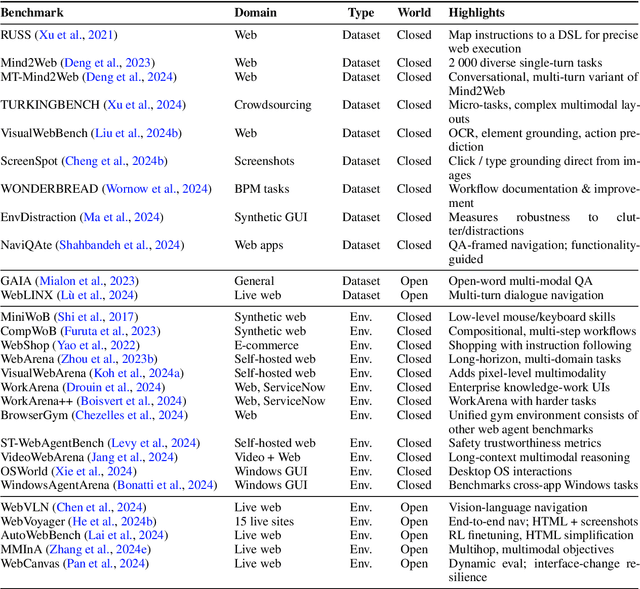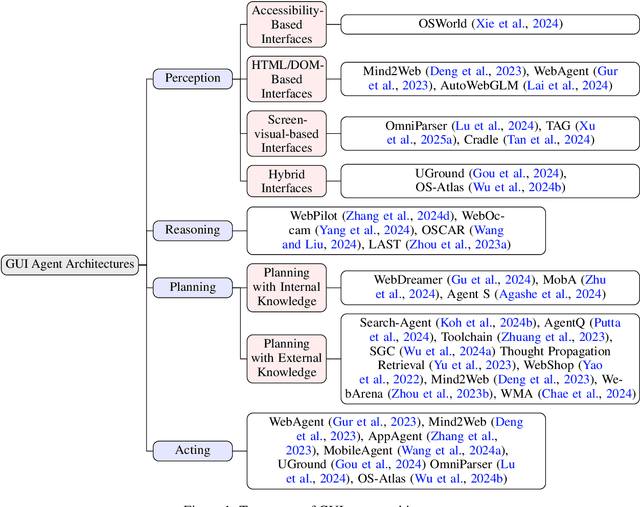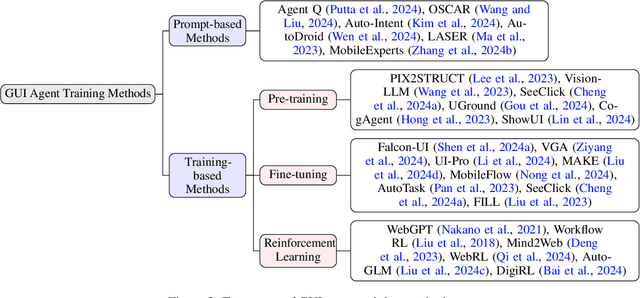Puneet Mathur
SQLSpace: A Representation Space for Text-to-SQL to Discover and Mitigate Robustness Gaps
Oct 31, 2025Abstract:We introduce SQLSpace, a human-interpretable, generalizable, compact representation for text-to-SQL examples derived with minimal human intervention. We demonstrate the utility of these representations in evaluation with three use cases: (i) closely comparing and contrasting the composition of popular text-to-SQL benchmarks to identify unique dimensions of examples they evaluate, (ii) understanding model performance at a granular level beyond overall accuracy scores, and (iii) improving model performance through targeted query rewriting based on learned correctness estimation. We show that SQLSpace enables analysis that would be difficult with raw examples alone: it reveals compositional differences between benchmarks, exposes performance patterns obscured by accuracy alone, and supports modeling of query success.
A Survey on Long-Video Storytelling Generation: Architectures, Consistency, and Cinematic Quality
Jul 09, 2025Abstract:Despite the significant progress that has been made in video generative models, existing state-of-the-art methods can only produce videos lasting 5-16 seconds, often labeled "long-form videos". Furthermore, videos exceeding 16 seconds struggle to maintain consistent character appearances and scene layouts throughout the narrative. In particular, multi-subject long videos still fail to preserve character consistency and motion coherence. While some methods can generate videos up to 150 seconds long, they often suffer from frame redundancy and low temporal diversity. Recent work has attempted to produce long-form videos featuring multiple characters, narrative coherence, and high-fidelity detail. We comprehensively studied 32 papers on video generation to identify key architectural components and training strategies that consistently yield these qualities. We also construct a comprehensive novel taxonomy of existing methods and present comparative tables that categorize papers by their architectural designs and performance characteristics.
ChartLens: Fine-grained Visual Attribution in Charts
May 25, 2025



Abstract:The growing capabilities of multimodal large language models (MLLMs) have advanced tasks like chart understanding. However, these models often suffer from hallucinations, where generated text sequences conflict with the provided visual data. To address this, we introduce Post-Hoc Visual Attribution for Charts, which identifies fine-grained chart elements that validate a given chart-associated response. We propose ChartLens, a novel chart attribution algorithm that uses segmentation-based techniques to identify chart objects and employs set-of-marks prompting with MLLMs for fine-grained visual attribution. Additionally, we present ChartVA-Eval, a benchmark with synthetic and real-world charts from diverse domains like finance, policy, and economics, featuring fine-grained attribution annotations. Our evaluations show that ChartLens improves fine-grained attributions by 26-66%.
GraphicBench: A Planning Benchmark for Graphic Design with Language Agents
Apr 15, 2025Abstract:Large Language Model (LLM)-powered agents have unlocked new possibilities for automating human tasks. While prior work has focused on well-defined tasks with specified goals, the capabilities of agents in creative design tasks with open-ended goals remain underexplored. We introduce GraphicBench, a new planning benchmark for graphic design that covers 1,079 user queries and input images across four design types. We further present GraphicTown, an LLM agent framework with three design experts and 46 actions (tools) to choose from for executing each step of the planned workflows in web environments. Experiments with six LLMs demonstrate their ability to generate workflows that integrate both explicit design constraints from user queries and implicit commonsense constraints. However, these workflows often do not lead to successful execution outcomes, primarily due to challenges in: (1) reasoning about spatial relationships, (2) coordinating global dependencies across experts, and (3) retrieving the most appropriate action per step. We envision GraphicBench as a challenging yet valuable testbed for advancing LLM-agent planning and execution in creative design tasks.
From Selection to Generation: A Survey of LLM-based Active Learning
Feb 17, 2025Abstract:Active Learning (AL) has been a powerful paradigm for improving model efficiency and performance by selecting the most informative data points for labeling and training. In recent active learning frameworks, Large Language Models (LLMs) have been employed not only for selection but also for generating entirely new data instances and providing more cost-effective annotations. Motivated by the increasing importance of high-quality data and efficient model training in the era of LLMs, we present a comprehensive survey on LLM-based Active Learning. We introduce an intuitive taxonomy that categorizes these techniques and discuss the transformative roles LLMs can play in the active learning loop. We further examine the impact of AL on LLM learning paradigms and its applications across various domains. Finally, we identify open challenges and propose future research directions. This survey aims to serve as an up-to-date resource for researchers and practitioners seeking to gain an intuitive understanding of LLM-based AL techniques and deploy them to new applications.
ChartCitor: Multi-Agent Framework for Fine-Grained Chart Visual Attribution
Feb 03, 2025

Abstract:Large Language Models (LLMs) can perform chart question-answering tasks but often generate unverified hallucinated responses. Existing answer attribution methods struggle to ground responses in source charts due to limited visual-semantic context, complex visual-text alignment requirements, and difficulties in bounding box prediction across complex layouts. We present ChartCitor, a multi-agent framework that provides fine-grained bounding box citations by identifying supporting evidence within chart images. The system orchestrates LLM agents to perform chart-to-table extraction, answer reformulation, table augmentation, evidence retrieval through pre-filtering and re-ranking, and table-to-chart mapping. ChartCitor outperforms existing baselines across different chart types. Qualitative user studies show that ChartCitor helps increase user trust in Generative AI by providing enhanced explainability for LLM-assisted chart QA and enables professionals to be more productive.
PlotGen: Multi-Agent LLM-based Scientific Data Visualization via Multimodal Feedback
Feb 03, 2025Abstract:Scientific data visualization is pivotal for transforming raw data into comprehensible visual representations, enabling pattern recognition, forecasting, and the presentation of data-driven insights. However, novice users often face difficulties due to the complexity of selecting appropriate tools and mastering visualization techniques. Large Language Models (LLMs) have recently demonstrated potential in assisting code generation, though they struggle with accuracy and require iterative debugging. In this paper, we propose PlotGen, a novel multi-agent framework aimed at automating the creation of precise scientific visualizations. PlotGen orchestrates multiple LLM-based agents, including a Query Planning Agent that breaks down complex user requests into executable steps, a Code Generation Agent that converts pseudocode into executable Python code, and three retrieval feedback agents - a Numeric Feedback Agent, a Lexical Feedback Agent, and a Visual Feedback Agent - that leverage multimodal LLMs to iteratively refine the data accuracy, textual labels, and visual correctness of generated plots via self-reflection. Extensive experiments show that PlotGen outperforms strong baselines, achieving a 4-6 percent improvement on the MatPlotBench dataset, leading to enhanced user trust in LLM-generated visualizations and improved novice productivity due to a reduction in debugging time needed for plot errors.
PlotEdit: Natural Language-Driven Accessible Chart Editing in PDFs via Multimodal LLM Agents
Jan 20, 2025

Abstract:Chart visualizations, while essential for data interpretation and communication, are predominantly accessible only as images in PDFs, lacking source data tables and stylistic information. To enable effective editing of charts in PDFs or digital scans, we present PlotEdit, a novel multi-agent framework for natural language-driven end-to-end chart image editing via self-reflective LLM agents. PlotEdit orchestrates five LLM agents: (1) Chart2Table for data table extraction, (2) Chart2Vision for style attribute identification, (3) Chart2Code for retrieving rendering code, (4) Instruction Decomposition Agent for parsing user requests into executable steps, and (5) Multimodal Editing Agent for implementing nuanced chart component modifications - all coordinated through multimodal feedback to maintain visual fidelity. PlotEdit outperforms existing baselines on the ChartCraft dataset across style, layout, format, and data-centric edits, enhancing accessibility for visually challenged users and improving novice productivity.
Multi-LLM Text Summarization
Dec 20, 2024



Abstract:In this work, we propose a Multi-LLM summarization framework, and investigate two different multi-LLM strategies including centralized and decentralized. Our multi-LLM summarization framework has two fundamentally important steps at each round of conversation: generation and evaluation. These steps are different depending on whether our multi-LLM decentralized summarization is used or centralized. In both our multi-LLM decentralized and centralized strategies, we have k different LLMs that generate diverse summaries of the text. However, during evaluation, our multi-LLM centralized summarization approach leverages a single LLM to evaluate the summaries and select the best one whereas k LLMs are used for decentralized multi-LLM summarization. Overall, we find that our multi-LLM summarization approaches significantly outperform the baselines that leverage only a single LLM by up to 3x. These results indicate the effectiveness of multi-LLM approaches for summarization.
GUI Agents: A Survey
Dec 18, 2024



Abstract:Graphical User Interface (GUI) agents, powered by Large Foundation Models, have emerged as a transformative approach to automating human-computer interaction. These agents autonomously interact with digital systems or software applications via GUIs, emulating human actions such as clicking, typing, and navigating visual elements across diverse platforms. Motivated by the growing interest and fundamental importance of GUI agents, we provide a comprehensive survey that categorizes their benchmarks, evaluation metrics, architectures, and training methods. We propose a unified framework that delineates their perception, reasoning, planning, and acting capabilities. Furthermore, we identify important open challenges and discuss key future directions. Finally, this work serves as a basis for practitioners and researchers to gain an intuitive understanding of current progress, techniques, benchmarks, and critical open problems that remain to be addressed.
 Add to Chrome
Add to Chrome Add to Firefox
Add to Firefox Add to Edge
Add to Edge